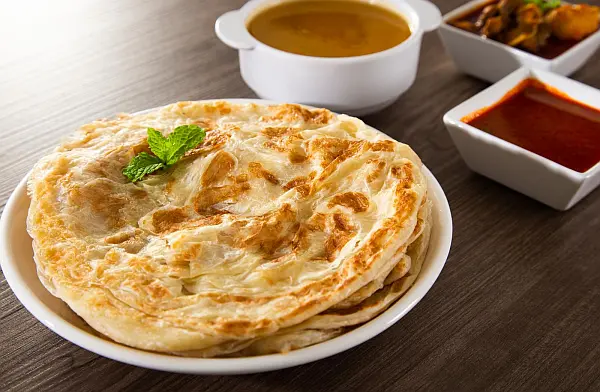Malabar Parotta
Kerala’s Flaky, Layered Flatbread Paired with Spicy Curries

The Malabar Parotta, also known as Kerala Parotta, is an iconic flatbread that hails from the Malabar region of Kerala, India. Characterized by its flaky, layered texture, this delicious bread has become a favorite across South India and beyond, often paired with spicy, flavorful curries. Made from all-purpose flour and rich in layers, the Malabar Parotta combines skillful cooking techniques with delightful flavors, creating a must-try experience for food lovers and travelers alike.
Origins and History of the Malabar Parotta
The Malabar Parotta is believed to have originated in the Malabar region, influenced by Arab trade and cultural exchanges that introduced different bread-making techniques to the Indian subcontinent. While flatbreads have been a staple in Indian cuisine for centuries, the Parotta's unique, layered structure sets it apart. Originally a street food staple, it is now a beloved part of Kerala’s cuisine, especially enjoyed in Tamil Nadu and Karnataka as well.
Preparation Techniques for Perfect Layers
The distinctive flaky texture of a Malabar Parotta is achieved through a meticulous preparation process. The dough, made from all-purpose flour, water, oil, and sometimes a bit of milk or sugar, is kneaded until soft and pliable. Here’s what makes the Parotta so unique:
- Rolling and Folding: After the dough rests, it is divided into small balls. Each ball is then rolled out as thin as possible and layered with a bit of oil before being folded repeatedly, creating layers.
- Coiling: The dough is coiled into a spiral and rolled out again, ensuring the layers remain intact but become thinner. This technique is the key to achieving the signature flakiness.
- Cooking: The Parotta is cooked on a hot griddle with a drizzle of oil until golden brown and crisp on the outside, with each layer visible and distinct. The result is a fluffy, crispy, and chewy bread with incredible texture.
Pairing Malabar Parotta with Curries
The Malabar Parotta’s slightly sweet, buttery taste complements the bold flavors of South Indian curries. Here are some of the popular dishes often paired with Malabar Parotta:
- Chicken Chettinad: A spicy, tangy curry made with a robust blend of spices, coconut, and pepper. The rich, thick gravy is perfect for scooping up with the flaky layers of the Parotta.
- Mutton Curry: Kerala-style mutton curry, slow-cooked with aromatic spices and coconut milk, is a popular pairing with Parotta. The hearty, tender meat and spicy sauce enhance the buttery taste of the bread.
- Vegetable Kurma: A mild, creamy vegetable curry made with a blend of vegetables, coconut, and spices. This dish is an excellent choice for vegetarians looking to enjoy the classic Parotta experience.
- Egg Curry: Kerala-style egg curry, simmered in a spicy coconut gravy with curry leaves and green chilies, offers a rich and comforting flavor that pairs beautifully with the Parotta’s texture.
- Beef Fry: In Kerala, beef fry or beef curry is often enjoyed with Parotta. The dry, spiced meat and crispy exterior are perfectly complemented by the flaky layers, making this a popular combination.
Cultural Significance and Popularity Across India
Malabar Parotta is more than just a meal in Kerala; it’s an emblem of the state’s culinary heritage. It’s a common sight in local eateries, street food stalls, and even high-end restaurants. The popularity of Parotta has spread across South India, where it’s enjoyed at celebrations, street-side vendors, and as comfort food in households. In Tamil Nadu, the “Parotta and Salna” combo (Salna being a spicy gravy) has become iconic, further cementing the Parotta’s place in South Indian cuisine.
Modern Adaptations and Variations
With its widespread popularity, several variations of the Malabar Parotta have emerged:
- Ceylon Parotta: Inspired by Sri Lankan influences, this variation is stuffed with spiced meat or vegetables, offering a more filling option.
- Kizhi Parotta: A modern twist, this involves wrapping the Parotta in a banana leaf along with meat and spices, then steaming it. The result is a moist, flavor-packed meal with a distinct aroma from the leaf.
- Coin Parotta: Smaller, bite-sized versions of the traditional Parotta, often served as an appetizer or as part of a multi-course meal.
- Whole Wheat Parotta: Health-conscious versions of the Parotta are made with whole wheat instead of all-purpose flour, providing a wholesome alternative while retaining the layered texture.
The Experience of Eating Malabar Parotta
Eating a Malabar Parotta is a sensory experience. The layers crackle as they pull apart, and the flaky texture provides a satisfying bite. When dipped in a hot, spicy curry, each layer absorbs the flavors, creating a burst of taste with every mouthful. It’s typically enjoyed with one’s hands, allowing diners to tear off pieces and savor each bite, adding to the enjoyment and authenticity of the meal.
Why You Must Try Malabar Parotta When Visiting Kerala
For travelers, trying Malabar Parotta is essential to experience Kerala’s street food and local cuisine culture. It’s a fantastic introduction to the bold flavors, cooking techniques, and hospitality that define the state’s culinary landscape. Street food stalls, local restaurants, and even home kitchens offer this iconic bread, often served hot and fresh. Its versatility makes it suitable for breakfast, lunch, or dinner, paired with a variety of curries.
Malabar Parotta is more than just a flatbread—it’s a culinary art form that showcases the rich flavors and textures of Kerala. Its flaky layers and buttery softness, paired with Kerala’s bold, spicy curries, create an unforgettable meal that represents the essence of the region’s cuisine. For food lovers and travelers alike, the Malabar Parotta promises an authentic taste of Kerala’s vibrant culinary heritage.
